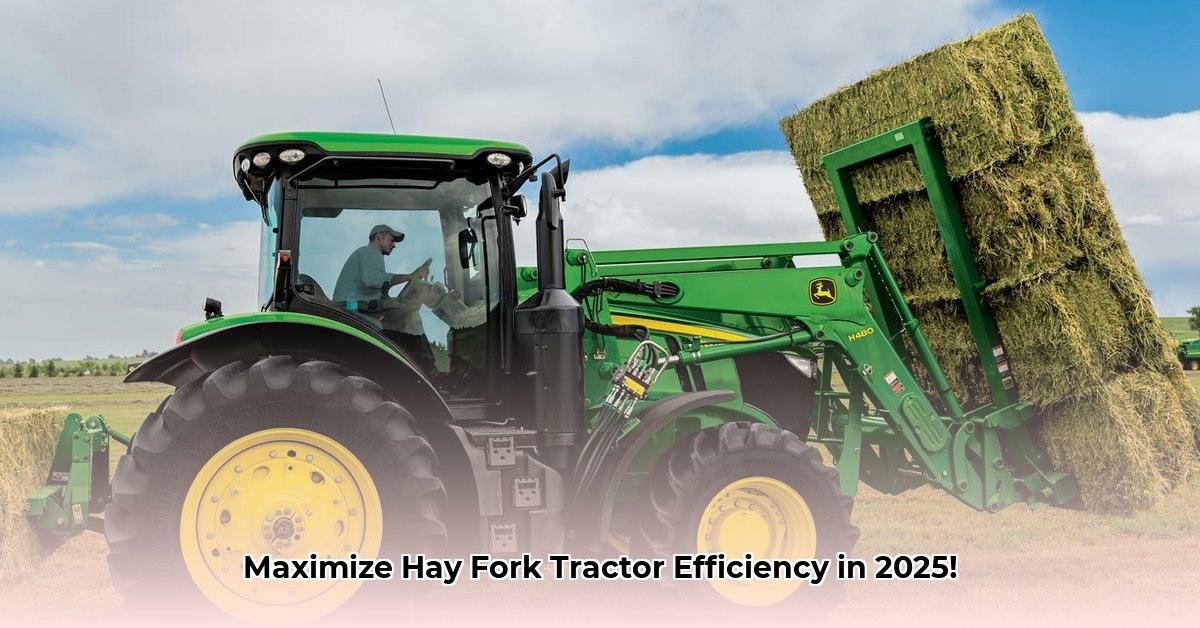
Understanding Your Hay Fork Options: More Than Just Forks!
Modern tractor hay forks aren't your grandpa's pitchforks. They significantly boost hay-handling efficiency. Choosing the right one depends on your farm's size and needs. Let's explore the options:
Single-tine forks: Ideal for smaller loads, delicate hay, or precise placement. Their maneuverability makes them perfect for smaller tractors or confined spaces.
Multi-tine forks: These workhorses handle larger quantities of hay quickly, ideal for larger operations.
Bale spears: Specifically designed for handling square or rectangular bales, offering efficient bale gripping. Ensure compatibility with your tractor's attachment system.
Choosing the right type hinges on your bale size and handling volume. For a comprehensive list of tractor implements, check out this helpful resource.
Picking the Perfect Hay Fork: Making an Informed Decision
Purchasing a hay fork is a significant investment requiring careful consideration. Here's a structured approach:
Budget: Hay forks vary significantly in price. Establish a realistic budget before beginning your search.
Tractor Compatibility: This is paramount! Check your tractor's hydraulic capacity to ensure safe and efficient operation. An improperly sized fork can damage your tractor or prove inefficient. Consult your tractor's manual.
Material Matters: Steel is a common, durable material. Lighter alloys offer fuel efficiency but might need more frequent maintenance. Consider the long-term costs and environmental impact of each material.
Warranty: A robust warranty indicates manufacturer confidence. Look for coverage of defects in materials and workmanship.
| Feature | Single-Tine Fork | Multi-Tine Fork | Bale Spear |
|---|---|---|---|
| Capacity | Low | Medium to High | High (bales) |
| Bale Type | Loose hay | Loose hay, small bales | Cubed bales |
| Maneuverability | High | Medium | Low |
| Cost | Low | Medium | High |
Safe Operation and Maintenance: Working Smart, Not Hard
Prioritizing safety is crucial. Follow these essential steps:
Pre-flight Check: Before starting, inspect the fork for any damage, loose parts or worn components.
Secure Attachment: Ensure correct attachment to your tractor's three-point hitch, and double-check all hydraulic connections.
Gentle Lifting: Lift hay slowly and steadily to prevent sudden movements or dropping of bales.
Load Inspection: Carefully check the load's balance and security before lifting. Avoid overloading.
Regular Maintenance: Regular lubrication, inspections of tines, welds, and hydraulic lines extend lifespan and prevent costly repairs.
The Total Cost of Ownership: A Long-term Perspective
The initial cost is just the beginning. Consider maintenance, repairs, and eventual replacement. "While precise cost figures are difficult to provide without knowing specific usage and maintenance practices, it's crucial to consider these long-term costs," says Dr. Amelia Hernandez, Agricultural Engineering Professor at Cornell University. Don't forget to compare the cost of using a hay fork with the cost of manual labor.
Sustainability and the Environment: Hay with a Conscience
Sustainable farming considers environmental impact. Factors include:
Material Choices: Steel's durability comes at an environmental cost. Lighter alloys can reduce fuel consumption but have their own production impacts. Complete lifecycle assessments are needed for each material.
Responsible Disposal: Prioritize recycling to minimize landfill waste.
Beyond Hay Forks: Exploring Other Options
While hay forks are excellent, other options exist. Round balers reduce handling, impacting efficiency depending on farm size and hay type. Selecting the best method involves weighing cost, efficiency, and environmental impact. "The best approach," notes John Miller, owner of Miller Family Farms, "depends on your individual operation's needs."
How to Compare Lifecycle Costs of Bale Spears vs. Hay Forks for Sustainable Farming
Choosing between bale spears and hay forks requires careful cost analysis. This involves:
Initial Costs: Include purchase price and any necessary modifications.
Operating Costs: Factor in fuel consumption per unit moved, influenced by tractor size and conditions.
Maintenance Costs: Estimate annual maintenance (greasing, repairs).
Repair Costs: Consult industry professionals for estimates, acknowledging the difficulty of precise prediction.
Disposal Costs: Consider costs and methods for responsible disposal, including potential recycling options.
Create a spreadsheet comparing these costs over several years for a clear picture. This provides a holistic view of total cost of ownership. Remember, sustainability involves responsible material choices, minimizing bale damage, and utilizing versatile tools. Your choice depends on your farm's scale and specific needs. Safety and training are paramount regardless of your equipment choice.